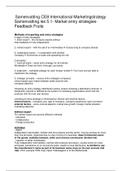Samenvatting CE8 International Marketingstrategy
Samenvatting les 5.1- Market entry strategies-
Feedback Fruits
Methods of exporting and entry strategies
3 types of entry strategies:
1. direct export – the company exports without
Intermediaries→ Fully independent
2. indirect export – with the aid of an intermediary→ Outsourcing to company abroad
3. cooperative export – in cooperation with another
Company→ Economies of scale and spreading the risk
3 principles:
1. naive principle – same entry strategy for all markets
Worldwide→ Does not think it through, just starts
2. pragmatic – workable strategy for each foreign market→ You know and are able to
implement the strategy
3. strategic principle – various entry strategies compared,
choice based upon match between sales channel and
company objective
Choosing an entry strategy (distribution policy) means choosing a distribution channel. A
distribution channel is defined as the system of marketing organizations which link the
producer with the end user abroad.
choosing an entry strategy is influenced by internal and external factors.
internal factors – company size, type of company, company experience, type of product
external factors – socio–cultural aspects, market size growth, foreign market situation,
marketing objective
Indirect export
For indirect export are several different methods:
- Individual
- Collaborative
- Foreign production
Individual
- Agent
Independent intermediair, familiar with the products and the sector, may be working for more
than one principal, organizes day–to–day running of a business, does not become owner
of the goods, mediates between, seller and receives commission (limited risk)
- Importer re-seller (wholesaler)
Fully independent intermediairy, familiar with products and sector, usually works for many
principals, sometimes on an exclusivity basis, resells to local distributors, is entitled to use
the manufacturer's name as part of its business name, buys on his own account (full
risk) →For example PON, they import Volkswagens in to the Netherlands.
, - Trading company
Fully independent intermediairy, familiar with products and sector, usually works for many
principals, including competitors, resells to local distributors, buys on his own account
(full risk) → Buys and divides over different companies.
- Distributor
Fully independent intermediairy, is familiar with the products and the sector, usually works for
a number of principals, all products are non-conflicting and complementary, resells to local
distributors, isn’t entitled to use the manufacturer's name as part of its business
name(!), buys on his own account (full risk)
- Piggyback marketing
International collaboration between two companies in the home market; one company (the
rider) uses the distribution channels and the sales organization of the other (the carrier).
The rider´s advantages include:
• Relatively low cost
• Use of carrier´s market expertise
• (limited) Influence on the way the products are marketed
Collaborative
- Joint selling
Arrangement whereby foreign company markets and sells product for another company in
foreign market and vice versa, advantages include:
• Independence of both partners
• Lower product cost (economies of scale)
• Limited financial demands
• Easy access to foreign market
→ Selling together. For example: Two different car companies in the same showroom.
- Export management company (EMC)
Acts as export department for one or several producers of goods and services; usually
specialized either by product or foreign market advantages include:
• Knowledge of products and trade
• Relatively low cost
• Ready access to the market (emc´s have large networks)
• Loss of marketing control is a disadvantage
EMC have employees in other countries with a very large network. In that specific country is
it a group of experts that know the market very well. Looks like an agent, but EMC has
market knowledge and an agent doesn’t. Don’t have anything to do with the marketing.
Foreign production
Strategic alliances:
Collaboration between two independent companies in commerce whereby core competences
are combined with purpose of achieving global advantage and better or easier market access
advantages are:
- Sharing large investments or costs
- Access to new technologies
- Acceleration in ROI
- Spreading risks
- Economies of scale
- Strengthening of competitive position




